Vietnam has quietly expanded its military capabilities in the South China Sea by purportedly deploying new Israel-made long-range mobile rocket launchers on five bases in the Spratly Islands in recent months, Reuters revealed on August 10.
Three unidentified sources claim that the so-called Extended Range Artillery Rocket (EXTRA) system has yet to be armed and has been carefully hidden from aerial surveillance on the disputed islands. The weapon systems, nevertheless, could be made operational within two to three days.
The EXTRA rocket launchers have purportedly been moved to the Vietnamese possessions in the Spratlys in anticipation of heightened tensions following the July ruling of the Hague-based Permanent Court of Arbitration on maritime entitlements and the status of features in the South China Sea.
“It is within our legitimate right to self-defense to move any of our weapons to any area at any time within our sovereign territory,” Vietnam’s deputy defense minister, Senior Lieutenant-General Nguyen Chi Vinh, told Reuters in June. However, Vietnam’s Foreign Ministry said that the information about the stationing of mobile rocket launchers in the Spratlys was “inaccurate.”
The EXTRA is a highly mobile weapon system and can be installed on either a truck or in a fixed installation. Vietnam procured the new mobile rocket launchers specifically with the Spratlys in mind given that it requires little logistical support—e.g., it only uses a small lightweight radar system—and has very low maintenance costs (EXTRA rounds come in disposable sealed canisters).
An EXTRA round, fitted with a GPS-based inertial navigation system, has a range of up to 130 kilometers (81 miles) and can carry a 125-kilogram (275 pounds) warhead. This would put Chinese installations in the Spratlys such as Subi, Fiery Cross, and Mischief Reefs within range of the weapon system. EXTRA is “effective against a wide range of high payoff targets across the tactical battlefield (Command & Communication Centers, logistic installations, transportation infrastructures and more),” according to the manufacturer’s website. It can be accurate within ten meters, GlobalSecurity.org claims.
Despite the deployment of the mobile rocket launchers, it will not fundamentally alter the military balance between Vietnam and China in the South China Sea. Chinese installations in the South China Sea have been within range of Vietnamese weapon systems for some time. Among other things, Vietnam procured Russian-made long-range K-300P Bastion coastal missile systems in 2011 and S-300 PMU-2 long-range surface-to-air missile systems in 2012. Vietnam has also been acquiring a number of new anti-ship and land attack cruise missiles, including the 3M-14E Klub supersonic cruise missile, which is capable of hitting mainland China. Consequently the EXTRA deployment should first and foremost be seen as a move by Hanoi to signal resolve to Beijing. As I noted previously:
Vietnam’s military planning vis-à-vis China is defensive in nature and built around A2/AD—or anti-access and areal denial strategies, exploiting asymmetrical advantages by, for example, fielding new diesel-electric submarines to exploit China’s known weakness in anti-submarine warfare.
Fuerthermore, I explained:
Vietnam’s ultimate goal is to deter China from deploying People’s Liberation Army Navy (PLAN) vessels in so-called gray zone coercion scenarios, which involves the use of China Coast Guard (CCG) and maritime militia vessels to blockade Vietnamese-held islands and features in the South China Sea while avoiding open military conflict.
According to Reuters, China has already condemned the EXTRA deployment on the Spratlys. “China has indisputable sovereignty over the Spratly islands and nearby waters,” the ChineseForeign Ministry said in a faxed statement on August 10. “China resolutely opposes the relevant country illegally occupying parts of China’s Spratly islands and reefs and on these illegally occupied Spratly islands and reefs belonging to China carrying out illegal construction and military deployments.”

































